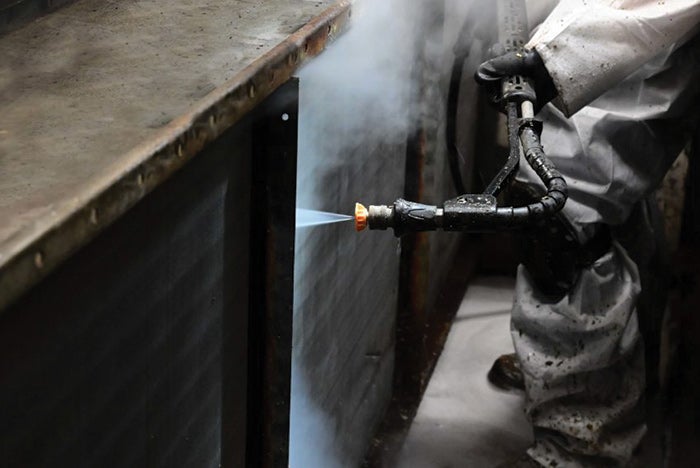Hospital improves air handling unit performance

An AQUIS technician performs a coil and tube restoration process on an air-handling unit.
Image courtesy of AQUIS
A large, New York state-based hospital was faced with multiple aging air-handling units (AHUs), with cooling coils performing well below design intent. Telltale signs of poor cooling coil performance can usually be seen and felt, translating to higher utility bills. The reason is because coils become impacted with dirt, debris, bacteria, viruses and biofilms made up of vast communities of microbes protected by a strong, tacky biopolymer called extracellular polymeric substances (EPS). Further complicating the matter, biofilms are highly resistant to conventional cleaning methods, and the massive surface area of cooling coils serves as an ideal site to support their proliferation.
As part of the hospital’s ongoing efforts to pursue energy efficiency and conservation opportunities, an innovative solution was desired to help identify and tackle excessive energy consumption specific to building cooling coils. Thanks to the hospital facility’s best practices, building energy retrofits (including regular upgrades to the central heating and cooling plants) are now a regular part of HVAC maintenance and operations programs. In this case, the hospital’s goal was to find an effective solution to restore cooling coil performance and reduce energy consumption. The hospital selected AQUIS, Orlando, Fla., to address one of the AHUs to evaluate coil and tube restoration as a potential solution for a larger AHU maintenance project.
In October 2020, AQUIS conducted a coil and tube restoration process on the AHU. The process follows a unique set of steps to thoroughly clean and protect the coils and tubes from future bacteria, viruses and biofilm buildup.
To verify effectiveness of the process, a measurement and verification (M&V) analysis was conducted by a third-party energy engineering consulting firm. The study was performed in accordance with the International Performance Measurement and Verification Protocol (IPMVP), which serves as a best practices framework to determine energy savings resulting from the implementation of an energy-efficiency program.
Specifically, AQUIS opted to employ the IPMVP Option B protocol defined by the Department of Energy’s Federal Energy Management Program (FEMP) as “Retrofit Isolation with all Parameter Measurement.” As outlined in the FEMP M&V guidelines, Option B can be more difficult and costly, but the results are more precise. The study involved measurement of several parameters, including air inlet and outlet conditions, supply and return water temperatures, and flow rate for both water and air across the cooling coil.
Following initial performance measurements, the AQUIS coil and tube restoration process commenced by first applying a safe and noncorrosive probiotic to break down and eliminate biofilms. Next, a mixture of super-heated water and steam was applied, penetrating deep within coils to remove any dust, debris and biofilms.
The combination of an innovative probiotic technology and a high-performance sanitization process is what effectively detaches and eliminates biofilms from deep within coils, resulting in coils that are cleaned at a microscopic level. AQUIS coil and tube restoration increased coil performance by as much as 31% and airflow by 14%, decreasing energy consumption. Additional benefits include extended coil service life and significantly improved indoor air quality.
The AHU demonstrated the following improvements in performance: 30% improved waterside coil capacity; 32% improved airside coil capacity; 14% improvement in airflow; 14% increase in chilled water temperature differential at identical water flow rates; and $12,500 calculated cost savings for the building from one AHU.
Conventional coil cleaning typically utilizes pressure washers and steam cleaners, which may fail to penetrate and clean biofilms deep within coils. Also, many standard coil cleaning products are made of toxic, corrosive, volatile organic compound-containing cleaning agents. The solution from AQUIS allowed the New York hospital to perform AHU renewal and optimization through an innovative refurbishment and restoration solution.




